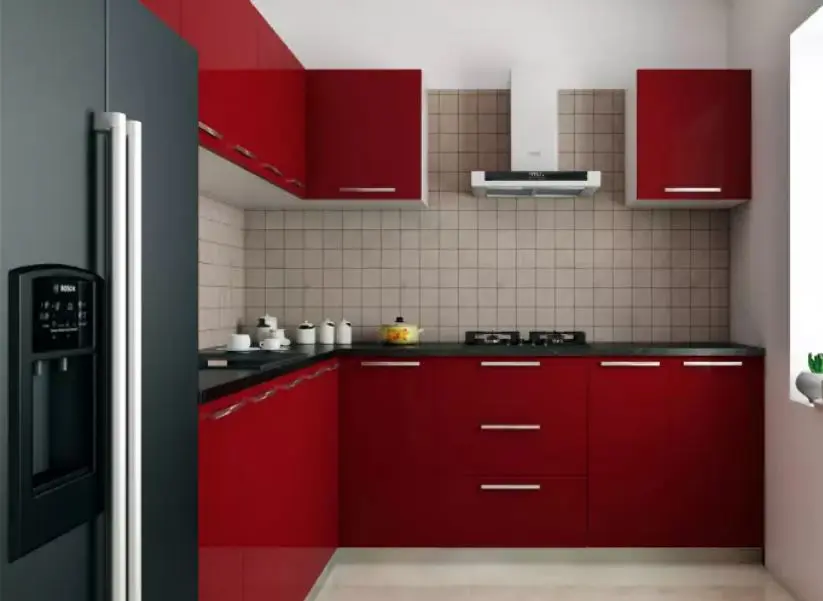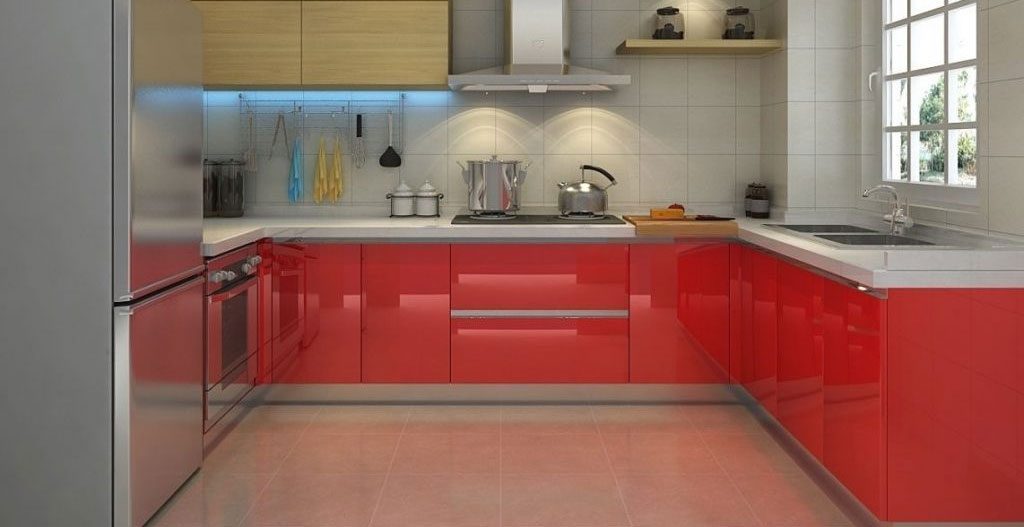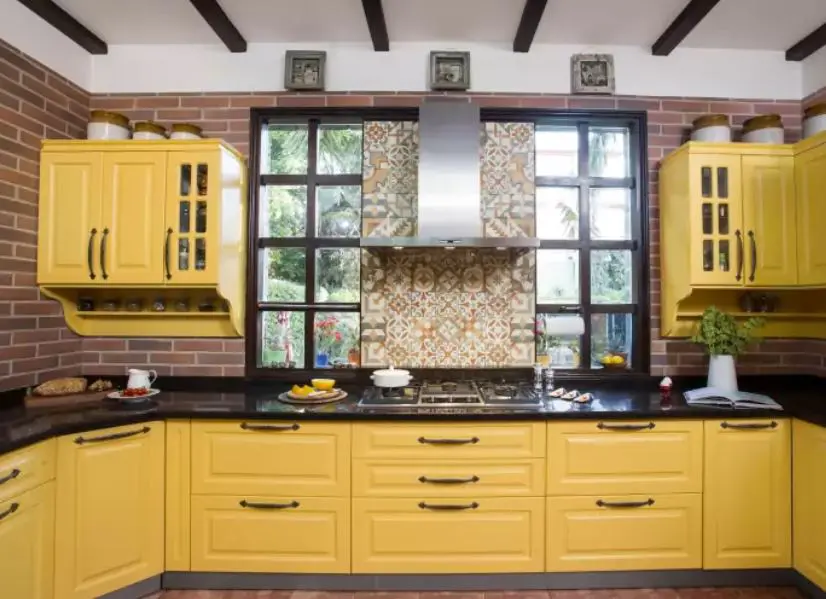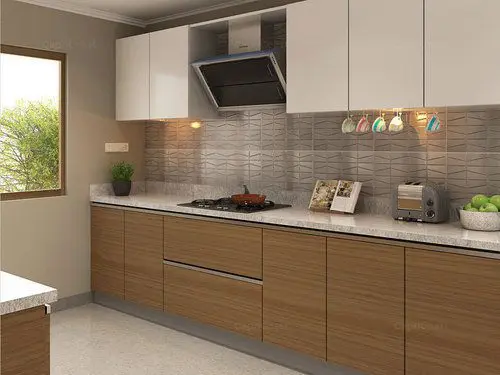The first glimpse of an artefact creates an impact on the viewer’s mind. Same theory pertains with your kitchen as well. In this article, the various finishes and materials that one can use for their kitchen shutters would be stated and what are the pros and cons of each would be mentioned as well. For better application and implementation of various finishes, It is advisable to be well aware of the material that each finish is made of, their durability and the variety of colours and textures that are available for each finish.
Shutter finishes that are available for selection and consideration while designing a kitchen shutter panel are as follows:
- Laminates
- Acrylic Sheets
- UV Shutters
- Membrane
- PU Paint
- Veneer finish
Laminate Shutters
Laminate shutters are 1mm thick mica sheet that comes in different colours and finishes. These sheets are pressed on the material of the shutters. This is the first advantage of this type of finish.

Laminate shutters are easy to use as they can be pressed over many kinds of boards and not only with smooth surfaces like Plywood/M.D.F./H.D.F. These shutters generally have the longest variety to offer, in terms of finishes as well as colours. Their finishes vary from matt, to emboss to gloss. These type of finish are very durable finish, used in kitchens and interiors. Laminates of good quality are usually available as a scratch-resistant variant.
There are many variants of laminates available in the market.
1. Based on finish : Matt, Suede and Glossy Laminates
Pros and Cons of laminate Shutters
Pros: Laminate shutters are that they are easy to clean, generally do not loose thier colour over a long period, easy to maintain and are the most affordable as compared to the other finishes.
Cons: Laminate shutters usually chip in the corners and get damaged when exposed to extreme heat.
Acrylic Shutters
These are 1mm thick sheets of acrylic that are pasted on Plywood/M.D.F./H.D.F. boards. Their reflective quality is different from that of the other gloss shutters. They have a mirror-like reflective finish. It gives your kitchen a high sheen. A good quality acrylic shutter has high scratch resistance, and maintains its colour and finish for at least eight years.

Pros and Cons of Acrylic Shutters
Pros: Acrylic Shutters are more durable and scratch resistance in comparison to the UV boards. They are also available in ultra matt finish, which provides a striking look and durable quality.
Cons: The drawbacks of this material are that it is expensive as compared to other finishes and it comes in limited colours. Dirt, fingerprints, scratches are easily visible on these glossy finishes.
u.V. Shutters
U.V. (Ultraviolet) shutter finish is created by painting boards of huge length and then coating them with UV protection. This is done to increase the durability of the finish as well as gives it a glossy finish.

Pros and Cons of U.V Kitchen Shutters
Pros: Generally, UV Shutters have better gloss quality than that of the laminate finish. They are good to be used in kitchens especially in combination with matt finishes.
Cons: The paint base used for creating UV shutters is usually thin and can get damaged easily. The range of variety available in UV shutters is limited as compared to laminates.
Membrane Shutters
Membrane Shutters are a 0.3 mm thick sheet that is pasted on top of an Plywood/ M.D.F./H.D.F. board. As the sheet is almost like a sticker with negligible thickness, it can give a great finish to the grooved shutters. It gives the shutter an edgeless smooth finish.

Pros and Cons of Membrane Shutters
Pros: Membrane Shutters give great finish as they can bend in all edges and corners. They give edgeless smooth finish to shutters
Cons: The major disadvantages of membrane shutters are that colour and shades are limited, they are not heat resistant. So this limits its usage as it leads to wearing effect of the sheet from the board in a very short period of two to three years.
P.U. Paint (polyurethene Paint) Shutters
Like laminate shutters, there is a wide range of paint finishes, the one with a high level of coating and proper buffing gives good gloss factor. These shutters have flawless edges. All the other kitchen shutter finish variants generally have an edgy look whereas, P.U. painting gives a sleek and seamless look to the shutters. Most of the furniture and kitchen brands use this finish widely. There is more variety in this finish than one can imagine.

Pros and Cons of PU finished Shutters
Pros: PU Finished shutters are quite durable and gives a glossy smooth finish
Cons: PU Finish is slightly less scratch resistance as compared to the acrylic boards.
Veneer Shutters
These are wood skins used in different types of polish to bring out a very rich and elegant look. Actual sheets of wood bark are pasted on plywod / M.D.F./H.D.F. boards. Polishing the surface is used to seize the look of the wood and bring out the natural grains of the wood.

Pros and Cons of Veener Shutters
Pros: Many different colours can be made in Veneers finish by coating the panel with different colours and polishes. This is an expensive and durable finish which can be used in all parts of the kitchen and other interiors as well. They have seamless edges and have a sleek look.
Cons: Kitchen with Veener shutters are quite expensive as compared to other finishes. Also, it is difficult to clean as the dust gets stuck in the veins of the wood.
Happho’s Recommendation
For Indian Kitchen where we recommend to use PVC laminates, membrane finish or Acrylic finish depending on the budget and the pros and cons mentioned above.
– Anshul Kulshrestha





